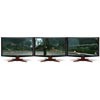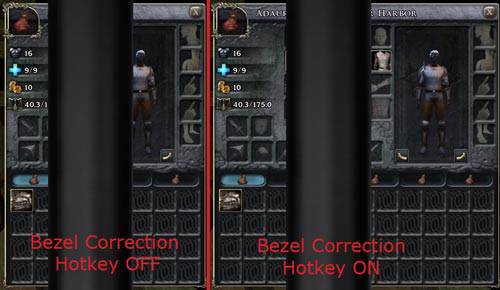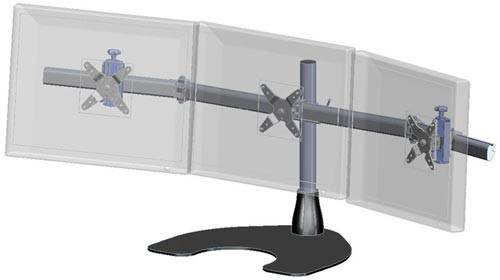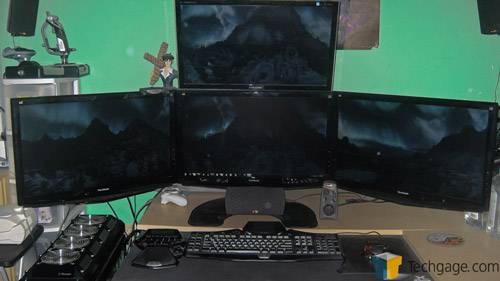- Qualcomm Launches Snapdragon 4 Gen 2 Mobile Platform
- AMD Launches Ryzen PRO 7000 Series Mobile & Desktop Platform
- Intel Launches Sleek Single-Slot Arc Pro A60 Workstation Graphics Card
- NVIDIA Announces Latest Ada Lovelace Additions: GeForce RTX 4060 Ti & RTX 4060
- Maxon Redshift With AMD Radeon GPU Rendering Support Now Available
The Basics of Multi-Monitor Gaming

The world of multi-monitor gaming is a small but ever growing community of dedicated individuals who enjoy a rich and immersive game-play experience. Multi-monitor gaming can be a complicated transition, however, this how-to guide is here to help ensure you have as few problems when you decide to pass through the veil of multi-monitor gaming.
Page 2 – Setting Things up
The prices of monitors have dropped significantly over the past few years, putting some of the larger sizes like 22″ and 24″ within a reasonable price range when you need to get three of them. The largest size you will probably want to consider is 27″, unless you have a large amount of room on your desk. I will touch on this when I discuss optional hardware.
The most common question is; “Why can’t I just use my old monitor and try to find others like it?” To find the exact model of your current monitor is going to be hard going, especially if you bought yours 5+ years ago. There are several reasons it is important for you to have the same model monitor for all three displays: You might run into resolution detection issues when enabling Eyefinity or Surround; one monitor might have a tint of grey and another a tint of blue, making color matching difficult, if not impossible to resolve; if there is any dynamic contrast, one monitor might be brighter than the others. I am not saying everyone will run into these exact problems, but these or other problems might happen and this is why I implore you to use the same model of monitor for your multi-monitor setup.

The size selection is just one part of your equation when you look at a monitor to purchase. One of the other most important things you need to look at is the resolution. I mentioned before that resolution would be a factor in the price of your active DisplayPort adapter and that is because a 2560×1600 resolution requires a dual-link active DisplayPort adapter which can cost about $100. If the resolution is 1920×1080 or lower, it only requires a single-link active DisplayPort adapter, which costs about $30.
Therefore, if you plan to run monitors that use 2560×1600, it would probably be cheaper if you get them with the DisplayPort already included if you’re going to go with AMD. If you’re going to go with NVIDIA and use SLI, this will not be a problem. If you use a single card, you would want to use the DisplayPort over HDMI because I have heard of technical issues popping up when people have converted from HDMI to DVI for that resolution.
The software is straight forward when it comes to configuring either AMD or NVIDIA’s multi-monitor solutions. I have used both; even though I haven’t used AMD’s in a while and I don’t recall it being problematic what so ever, NVIDIA was the worst of the two when it first entered the multi-monitor revolution, but have learned from its mistakes and setup is just as simple. As you can see with NVIDIA’s Surround configuration utility, you’ll be shown a graphic illustrating, what ports you need to plug your monitors into, and it will tell you if you need to adjust if it’s not hooked up correctly.
I cannot honestly recall if AMD does this the same way, but NVIDIA will place numbers on your screen and give you a set of virtual monitors with numbers; all you need to do is match up those virtual monitors with the ones on your screens. Once you reach the end of the setup, you can opt to setup Bezel Correction. What this does is correct the distance between your monitor’s edges (bezel) so when you look at an image they are perfectly aligned with no separation. The left side of the below screen capture shows a perfect image, but that is without taking into account your monitors bezel. On the right, it may look like the image is broken, but when viewing this image from a distance, it was perfectly lined up and seamless. This has to be setup manually every time with NVIDIA’s drivers, I know that it’s working on making it possible to retain those setting, but as of right now it isn’t perfect, thus I never use bezel correction but you might want to.
As of right now, NVIDIA’s Surround is the only multi-monitor solution to offer something called a Bezel Peeking Hotkey. What this does is toggle your bezel correction on and off in game so if the game doesn’t properly line up between the monitors with bezel correction enabled, you don’t have to change anything in game. The reason this will happen is because bezel correction adjusts your 3D images to appear seamless, but in a game with a 2D element like an inventory or HUD, it will be partially hidden.
With the hardware and monitors picked, now you have to decide where you are going to put it all. It’s possible you might not be able to support all three monitors on your desk at once, even if you have the space. A solution might be to acquire a monitor stand. This is purely optional but it does require you consider something else when purchasing a monitor; it must support the VESA mount option. There are many monitor stands out there and I encourage you to explore your options based on your needs and the quality of the stand before making any purchase.
I currently use a monitor stand myself. The one I ended up purchasing was the Ergotech Triple Horizontal LCD Monitor Arm Desk Stand. The reasons for me buying this stand was simple, the wide heavy base and the overall quality. I had read many reviews of other stands and this was one that would not wobble when it had only two monitors mounted on it. If you purchase this from any distributor, the manufacturer will promptly replace any defective part if they were damaged in shipping. The maximum monitor size is 24″ per monitor with the standard unit; there are replacement parts that you purchase that will extend the stand’s support up to 27″.
I purchased the standard unit from Amazon but the folks over at Widescreen Gaming Forum have begun to offer the Ergotech stands on their site. They even offer the 27″ upgrade in one package at a cheaper rate then buying all the additions separately. The additions do not end there; they include a 3×1 option if you choose to run a fourth monitor above the center of your multi-monitor setup. This is possible with any of the multi-monitor solutions, but you might have to buy another active DisplayPort adapter for AMD and if you run one 680/670.
I personally own two NVIDIA GTX 580s in SLI for my Surround setup, and for me to run my fourth monitor I had to install my 9600 GT. Unfortunately, owners of previous generation NVIDIA cards are required to add a third card if you want to have a fourth monitor. This is why I recommend the 680/670 card if you plan to start your Surround experience from scratch. The NVIDIA GTX 690 is on the market and does support up to four monitors, but it does require a Mini-DisplayPort adapter and an active DisplayPort adapter if you change it to DVI or HDMI.
This concludes this guide to multi-monitor gaming. I have tried to cover the basics along with some of the hidden problems associated with it, but I hope it doesn’t stop you from seriously considering the move to multi-monitor gaming. The experience is unlike anything you’ve had before and I am quite sure you will not want to go back to a single monitor for gaming if you have the choice. Happy Fragging!
Discuss this article in our forums!
Have a comment you wish to make on this article? Recommendations? Criticism? Feel free to head over to our related thread and put your words to our virtual paper! There is no requirement to register in order to respond to these threads, but it sure doesn’t hurt!
Support our efforts! With ad revenue at an all-time low for written websites, we're relying more than ever on reader support to help us continue putting so much effort into this type of content. You can support us by becoming a Patron, or by using our Amazon shopping affiliate links listed through our articles. Thanks for your support!









